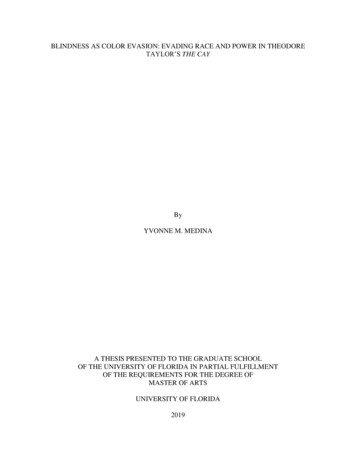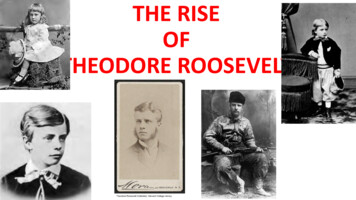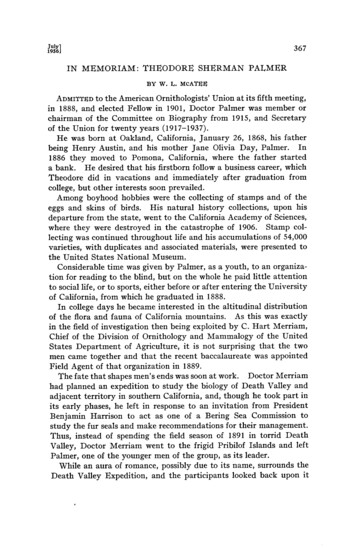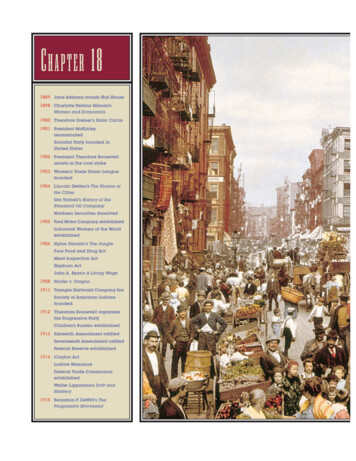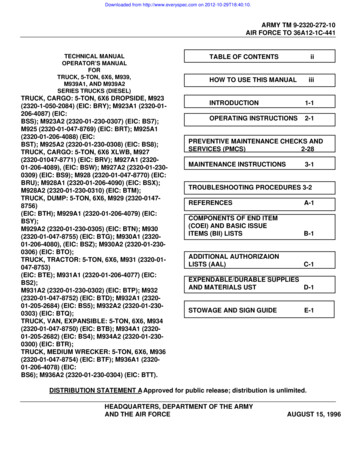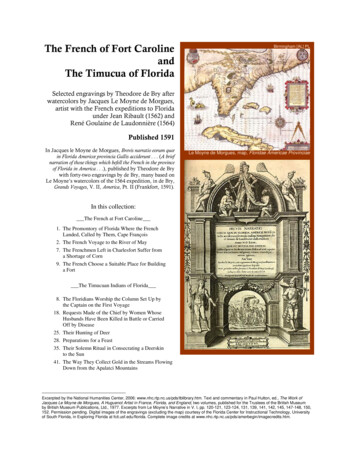
Transcription
The French of Fort CarolineandThe Timucua of FloridaBirmingham [AL] PLSelected engravings by Theodore de Bry afterwatercolors by Jacques Le Moyne de Morgues,artist with the French expeditions to Floridaunder Jean Ribault (1562) and*René Goulaine de Laudonnière (1564)Published 1591In Jacques le Moyne de Morgues, Brevis narratio eorum quœin Florida Americœ provincia Gallis acciderunt . . . (A briefnarration of those things which befell the French in the provinceof Florida in America . . .), published by Theodore de Brywith forty-two engravings by de Bry, many based onLe Moyne’s watercolors of the 1564 expedition, in de Bry,Grands Voyages, V. II, America, Pt. II (Frankfort, 1591).Le Moyne de Morgues, map, Floridae Americae ProvinciaeIn this collection:The French at Fort Caroline1. The Promontory of Florida Where the FrenchLanded, Called by Them, Cape François2. The French Voyage to the River of May7. The Frenchmen Left in Charlesfort Suffer froma Shortage of Corn9. The French Choose a Suitable Place for Buildinga FortThe Timucuan Indians of Florida8. The Floridians Worship the Column Set Up bythe Captain on the First Voyage18. Requests Made of the Chief by Women WhoseHusbands Have Been Killed in Battle or CarriedOff by Disease25. Their Hunting of Deer28. Preparations for a Feast35. Their Solemn Ritual in Consecrating a Deerskinto the Sun41. The Way They Collect Gold in the Streams FlowingDown from the Apalatci Mountains*Excerpted by the National Humanities Center, 2006: www.nhc.rtp.nc.us/pds/tblibrary.htm. Text and commentary in Paul Hulton, ed., The Work ofJacques Le Moyne de Morgues, A Huguenot Artist in France, Florida, and England, two volumes, published for the Trustees of the British Museumby British Museum Publications, Ltd., 1977. Excerpts from Le Moyne’s Narrative in V. I, pp. 120-121, 123-124, 131, 139, 141, 142, 145, 147-148, 150,152. Permission pending. Digital images of the engravings (excluding the map) courtesy of the Florida Center for Instructional Technology, Universityof South Florida, in Exploring Florida at fcit.usf.edu/florida. Complete image credits at www.nhc.rtp.nc.us/pds/amerbegin/imagecredits.htm.
I. THE PROMONTORY OF FLORIDA WHERE THE FRENCH LANDED,CALLED BY THEM, CAPE FRANÇOISOn the first voyage to the province of Florida the French landed at a promontory * which was of no greatelevation (for the coast was low-lying) but densely wooded with extremely tall trees. In honor of Francethe captain of the fleet named it Cape François and its position in about 30 from the equator. Followingthe coast north from there they found a wide and pleasant river at whose mouth they dropped anchor sothat next day they might explore more closely. On the second voyage Laudonnière called this the River ofDolphins because when putting in there he had seen agreat many dolphins swimming in it. When theylanded on the banks of the river they saw manyIndians whose bearing had suggested that they wouldreceive them in a most civil and friendly way, as wasproved in practice. There the Indians gave a numberof skins to the captain and also promised that theywould show them their chief who had not stood upwith them but was still reclining on strewn branchesof laurel and palm. He presented the captain with ahuge skin decorated all over with a kind of realisticrepresentation of various wild animals.* Ribault’s landfall at the cape of Anastasia Island (near St. Augustine, Florida) occurred April 29, 1562. This first French expeditionto Florida, planned as a refuge for French Protestant Huguenots (and which Le Moyne did not accompany), is depicted in the firstseven engravings in de Bry’s publication, which de Bry probably based on the account by Laudonnière, who was second-incommand in 1562 and captain of the expedition in 1564.National Humanities Center2
II. THE FRENCH VOYAGE TO THE RIVER OF MAYEmbarking again they set sail for another place and before they landed were greeted by another crowd ofIndians who went into the river up to their shoulders and offered them little baskets * full of maize andwhite and red mulberries, while others offered their help in bringing them to land. When they landed theycaught sight of their chief who was accompanied by two sons and a crowd of Indians armed with bowsand quivers full of arrows. After exchanging greetings they went off into the woods hoping to discoversome remarkable things there; but they saw nothing except trees bearing red and white mulberries, andthe tops of the trees were teeming with silkworms. They named that river the River of May † since theyhad sighted it on the first of that month.* “The baskets carried by the running Indians are . . . shaped like European rather than native artefacts.” [Hulton, ed., The Work ofJacques Le Moyne de Morgues, 1977, v. I, p. 203]†St. Johns River, near present-day Jacksonville, Florida.National Humanities Center3
VII. THE FRENCHMEN LEFT IN CHARLESFORT SUFFER FROM A SHORTAGE OF CORNA short time after Captain Ribault’s departure from Florida, those who had been left in Charlesfort * (thestronghold which he had built above a small stream, on an island which stands in the larger, north-facing,channel of Port Royal) began to suffer from a shortage of corn. They therefore canvassed variousopinions about how to deal with this problem and decided that nothing would be more advantageous thanto approach the Chief Ouadé and his brother Couëxis. Accordingly they sent off some of their men tothem, and when they had travelled in an Indian canoe about ten miles through the inland region, theycame upon a large and fine looking river of sweet water, in which they saw a great many crocodiles,much larger than those of the Nile, the river banks being covered with tall cypresses. After staying in theplace a short while they went on farther and reached the chief Ouadé who received them most civilly.They explained to him why they had come and begged him not to abandon them in their great need. Whenhe understood the position he sent messengers to his brother Couëxis to ask for maize and wheat. Thelatter immediately responded, for the messengers returned with provisions very early next day, and when,at the chief’s order, the corn had been carried into the boat, the Frenchmen, much delighted with hisgenerosity, wished to say goodbye. But he would not allow it and kept them back with him for the day,entertaining them jovially. The following morning he showed them his fields of millet and maize and toldthem not to let themselves be oppressed by shortage as long as that corn lasted. Then the chief dismissedthem and they returned to their comrades by the same way that they had come.* Before returning to France, Captain Jean Ribault ordered the construction of a fort, Charlesfort, which was manned by thirtysoldiers who abandoned the fort several months later and were rescued by an English ship.National Humanities Center4
VIII. THE FLORIDIANS WORSHIP THE COLUMNSET UP BY THE CAPTAIN ON THE FIRST VOYAGEWhen the French had landed in the province of Florida, on the second voyage made under Laudonnière’sleadership, he went down on shore himself, accompanied by twenty-five arquebusiers, and was receivedin greeting by the Indians (for these had come up in crowds to see them). Even the chief Athore came,who lives four or five miles from the seashore; and when they had exchanged gifts and all manner ofcourtesies he indicated that he wished to show them something special and asked them for this reason togo along with him. They agreed, but because they were aware that he was surrounded by a great numberof his subjects, they set out with caution and vigilance in his company. In fact he led them to the island onwhich Ribault had placed on top of a certain mound a marker of rock carved with the arms of the King ofFrance. Drawing close they noticed that the Indians were worshipping this stone as if it were an idol. Forwhen the chief himself had saluted it and shown it the sort of reverence he was accustomed to receivefrom his subjects, he kissed it; his people copied him and encouraged us to do the same. In front of thestone were lying various offerings of fruits of the district and roots that were either good to eat ormedicinally useful, dishes full of fragrant oils, and bows and arrows; it was also encircled from top tobottom with garlands of all kinds of flowers, and with branches of their most highly prized trees. Afterwitnessing the rites of these poor savage people they returned to their comrades with the intent to searchout the most suitable site for building a fort.This chief Athore is an extremely handsome man, intelligent, reliable, strong, of exceptional height,exceeding our tallest men by a foot and a half, and endowed with a certain restrained dignity, so that inhim a remarkable majesty shone forth. He married his mother and by her raised more children of bothsexes whom he produced for us by slapping his thigh; and indeed, after she had been betrothed to him, hisfather Satouriwa did not touch her anymore.National Humanities Center5
* “The engraving (previous page) is the only one of the De Bry plates for which the original [Le Moyne] miniature survives [seebelow]. . . . [S]ome of the details of the body decoration, fruit and garlands, have been slightly modified and Athore’s features withhis high cheekbones and aquiline nose somewhat Europeanized.” [Hulton, ed., The Work of Jacques Le Moyne de Morgues, 1977,v. I, p. 205]“ The baskets here [referring to the de Bry engraving, p. 5, based on Le Moyne’s watercolor below] seem European and not Indianin both construction techniques and shape. The pack baskets are especially clearly a European type. Southeastern Indian packbaskets were not shaped like these, whereas there is good evidence for Flemish and French pack baskets with high backs, . . . Theexotic fruits in the basket are very improbable really impossible for Florida. Some seem to be modelled on European rootcrops. . . . Many of Le Moyne’s colors are wrong as is especially evident in the European complexions and hair colors of the Indians,and the gold and bright colors of the tattoo patterns (rather than grey or blue). But two elements here are independently confirmedfor Indians of this region. The two vessels with handles are closely paralleled archaeologically: by a wooden bowl, measuring 9 x 6inches, from the site Su-5 on the Itchtucknee River (Florida State Museum . . .) . . . and by several pottery examples excavated by6C. B. Moore. The pendants hanging from Athore’s belt, although they are not especially distinctive in shape, can be matchedamong the stone and shell pendants especially those called “plummets” common in late archaeological remains from this7region. This plate and several others . . . strikingly imply a relation of equality and friendliness between the French and Indianleaders. Their postures and their relative size suggest a status equivalence that would be surprising in later periods.”67C. B. Moore, “Certain sand mounds of the St. John’s River, Florida,” Journal of the Academy of Natural Sciences of Philadelphia, n.s., X (1894),pp. 68, 69, 80, pls. 5, 8, 17, 21.J. M. Goggin, Space and Time Perspective in Northern St. Johns Archeology, Florida (Yale University Publications in Anthropology, no. 47,1952), pp. 121-2; and various illustrations in Moore, op. cit.[Hulton, ed., The Work of Jacques Le Moyne de Morgues, 1977, v. I: pp. 163-164. [Commentary by W. C. Sturtevant]Jacques Le Moyne de Morgues, “Athore shows Laudonnière the Marker Column set up by Ribault”[during the first French expedition in 1562]Watercolors and bodycolors with touches of gold on vellum, and traces of black chalk outlines; mounted withina gold border; pictorial surface 180 x 260 mm; 7 x 10¼ in. New York Public Library. Permission pending.[Text in Hulton, ed., The Work of Jacques Le Moyne de Morgues, 1977, v. I, plate 6]National Humanities Center6
IX. THE FRENCH CHOOSE A SUITABLE PLACE FOR BUILDING A FORT *When many of the rivers of that region had been explored the conclusion was finally reached that a baseshould be chosen on the River of May rather than on any other river; because they had already noticedthat it, more than the rest, was rich in millet and corn besides gold and silver which were found there onthe first voyage. So they steered their course towards that river, and when they had sailed up it to a certainplace near a hill, that was judged more suitable forbuilding a fort that any other which they had seenhitherto. At first light next day, when they had offeredprayers to God and given thanks for their safe arrival inthat province, everybody became active. A level area wasthen measured out in the form of a triangle, and everyonebegan to put his back into the work, some digging theground, some bundling together twigs that they had cut,some constructing a wall; for nobody had come without aspade, a saw, an axe, or some other tool both for cuttingdown trees and for building a fort. They worked so hardthat soon the task was progressing well.* “The location of Fort Caroline has not been finally determined except that it was on the south bank of the St. Johns River, perhaps1on St. Johns Bluff” [near present-day Jacksonville, Florida]. [Hulton, ed., The Work of Jacques Le Moyne de Morgues, 1977, v. I, p.205]1National Humanities Center7Woodbury Lowery, Spanish settlements II, Florida 1562-1574 (1905), pp. 405-7.
XVIII. REQUESTS MADE OF THE CHIEF BY WOMEN WHOSE HUSBANDSHAVE BEEN KILLED IN BATTLE OR CARRIED OFF BY DISEASE *The wives of those who have fallen in battle or died of disease are accustomed to gather on a day thatthey judge to be somwhat favorable for addressing the chief. Approaching him with much grief andwailing they squat on their heels and cover their faces with their hands, and with loud cries and pleadingsseek vengeance of the chief for their dead husbands. They ask for assistance, so that they can maintain alivelihood as widows, and permission to marry again at the time prescribed by law. The chief has pity onthem and grants their request. They return home weeping and wailing as a sign of the love they bore theirhusbands. When they have spent some days in mourning, and have taken to their husbands’ graves theirweapons and the cup they used to drink from, they weep afresh and carry out other womanly customs.* “The text that accompanies and explains the engravings, and the general topics of the pictures themselves, coincide quite well withthe independent documentary evidence on Timucuan culture and with comparative data on other Southeastern Indian cultures. It ismainly the concrete details that seem wrong or distorted. . . . . . Le Moyne supplied at least a few sketches based on his observations either directly or by means of his memory of localartifact forms. Good examples are the small bowls with handles, the bird leg ear ornament, the oval metal pendants, and the longstemmed tobacco pipe, That is a surprisingly short list. . . . . . While one does not expect European artists of this period to depict non-European anatomy and facial features accurately, theskin and hair color chosen by Le Moyne in the surviving original miniature are surprising for one who must have remembered Indiancoloring. The wavy hair of the engravings is also clearly wrong.” [Hulton, ed., The Work of Jacques Le Moyne de Morgues, 1977,v. I, pp. 70-71; commentary by W. C. Sturtevant]National Humanities Center8
XXV. THEIR HUNTING OF DEERThe Indians use a device for capturing deer which we had never seen before. They know how to fit theskins of the largest deer they have been able to catch to their own bodies in such a way that, with its headadjusted to their head, they can look throughthe eye-holes as if through a mask. Thusarrayed they approach as near as possible tothe unsuspecting deer (having previouslynoted the time at which the deer go to drinkat the river) and, with bow and arrow intheir hands, are able to shoot them easilysince they are extremely common in thatregion. They protect their left arm with thebark of trees from being hurt by the bowstring (nature having taught them this). Andindeed, when they have re-moved the skinsfrom the deer, they know how to preparethem, not with a metal blade, but withshells, with marvelous precision; and I donot think anyone is to be found in the wholeof Europe who can prepare them soskillfully.National Humanities Center9
XXVIII. PREPARATIONS FOR A FEAST *At the time of year when they are in the habit of holding a communal feast the cooks are speciallyselected for the task. First of all they place over thick logs a large, round, earthen vessel which they knowhow to make and fire so precisely that water can be boiled in it as well as in our cauldrons. They light afire under it, one of them holding in his hand a small fan which is very effective for getting a fire going.The chief cook throws what is to be cooked into the pot, some pour water into a trench for scouring,another brings water in a vessel made like a bucket, and yet another crushes herbs for garnishing the foodon some flat stone; and all the time the women busy themselves in selecting what is necessary forcooking. However, although they hold great feasts in their own way, yet they are temperate in theireating, as a result of which they live for a long time. For one of their chiefs assured me that he was threehundred years old, and that his father, whom he showed me, was fifty years older than he; and I can trulysay, that when I saw him, I thought I was looking at no more than human bones covered with skin. Theycertainly put Christians to shame who reduce their span of life by holding immoderate feasts and drinkingparties, and who deserve to be handed over for training to these base uncivilized people and brutishcreatures in order to learn restraint.* “Most of the vessels here seem to be European in shape. However, the scoop-shaped basket in front of the fire (and perhaps the1one held over the pot) can be matched quite well by one of the basket shapes used in maize preparation by the modern Choctaws.Bernadette Boucher (personal communication) has suggested that the man pouring water may be leaching acorns, perhapspounded into a meal by the man in the left background. There is archaeological evidence from northern Florida for shallow stone2mortars that might have served as the basis for the one drawn here. The text [Le Moyne] to the plates offers no explanation for thecircular objects piled in the foreground. They are shaped like the metal ornaments worn by men in other illustrations, but thereseems no reason for these to be shown here. More likely the engraver has misinterpreted two piles of shellfish shown in the drawinghe was copying. The illustration shows a variety of foods, among which one would expect to find shellfish.”12See D. I. Bushnell, Jr., “The Choctaws of Bayou Lacomb,” Bureau of American Ethnology, Bulletin, no. 48 (1909), pl. 9.P. Ripley and Adelaide K. Bullen, “Stone mortars in Florida,” Florida Anthropologist (Gainesville, Fla., 1974), vol. xxvii, no. 4, pp. 169-70.[Hulton, ed., The Work of Jacques Le Moyne de Morgues, 1977, v. I, pp. 211-212; commentary by W. C. Sturtevant]National Humanities Center10
XXXV. THEIR SOLEMN RITUAL IN CONSECRATING A DEERSKIN TO THE SUNEvery year, a little before their spring (at the end of February, in fact), the chief Outina’s subjects take theskin, complete with antlers of the biggest stag they have been able to catch. They stuff it with all kinds ofthe choicest plants that their land produces, sew it upagain, and deck the horns, the throat, and the rest ofthe body with their more special fruits made up intowreaths or long garlands. Thus decorated, it iscarried away to the music of pipes and singing into avery wide and beautiful plain, and there it is placedon a very tall tree trunk, with its head and chestturned towards the sunrise, prayers bring repeatedlyuttered to the sun that he should cause to grow againin their kindom good things similar to those offeredto him.The chief with his sorcerer is nearest to thetree and gives the lead in what is said, with thepeople who are farther away responding. When theyhave greeted the sun the chief and the rest of thepeople go away leaving the skin there until thefollowing year. This sort of ceremony is repeatedeach year.National Humanities Center11
XLI. THE WAY THEY COLLECT GOLD IN THE STREAMSFLOWING DOWN FROM THE APALATCI MOUNTAINS *A long way from the place where our fort was built there are highmountains, called the Apalatci in the Indian language, where, as may beseen from the map, three large streams rise and wash down silt in whicha lot of gold, silver, and copper is mixed. For this reason those who livein that area make channels in the river beds, so that the silt, which isborne along by the water, may sink into them because of its weight.Carefully removing it from there they take it to a certain place, andsome time afterwards they again remove from the channels the siltwhich has fallen and collect it together. They put it in canoes andtransport it down a great river, which we named the River of May andwhich flows into the sea. The Spaniards now know how to exploit thewealth which comes from this source.* “Apart from Le Moyne there is no evidence whatever that at this early period the Indians north of Mexico extracted gold from waterby panning. The separate use of gold by the Indians in any form at this time, except from Spanish sources, remains unconfirmedand so far in Indian excavations there is a complete lack of gold objects which are not of Spanish origin. Yet the metal exists in theform of gold dust in inland waters from South Carolina to Virginia, particularly in the foothills of the Blue Ridge. But the methodindicated by Le Moyne would have been quite unsuited to the collection of gold dust. It is more likely that copper was the metal inquestion (the Indians used the same word for the two), and the basket-screening indicated could have produced coarse metalparticles and larger nuggets.”[Hulton, ed., The Work of Jacques Le Moyne de Morgues, 1977, v. I, pp. 215; commentary by David B. Quinn]National Humanities Center12
* Ribault's landfall at the cape of Anastasia Island (near St. Augustine, Florida) occurred April 29, 1562. This first French expedition to Florida, planned as a refuge for French Protestant Huguenots (and which Le Moyne did not accompany), is depicted in the first

